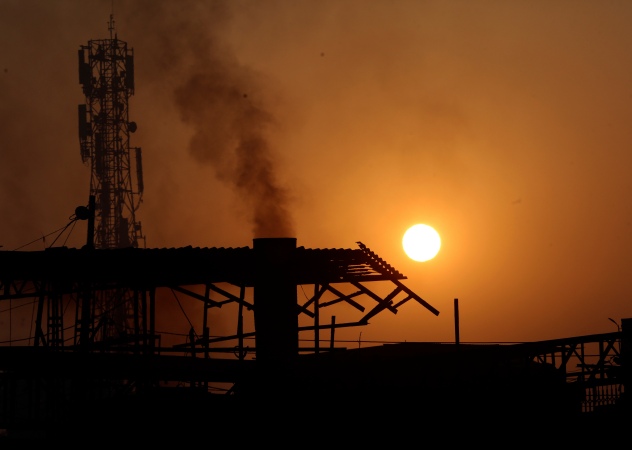  |
|
Smoke belches from a steel factory as the sun rises in Lahore, Pakistan, Saturday, Dec, 18. 2021. (AP Photo/K.M. Chaudary) |
Lahore, Pakistan, is a historic city in the northeastern part of the country and sits squarely in the Middle East, near Afghanistan, Iran and India. It’s the second largest city in Pakistan, and the summers there routinely see temperatures climb to 104 degrees Fahrenheit (40 degrees Celsius) or higher.
New analysis from Climate Central, a consortium of independent climate scientists and journalists, suggests that if current emissions trends continue, summertime in Houston, Texas, will start looking a lot more like Lahore.
“The Shifting Cities project visually and vividly shows what a couple of degrees of warming means – it shifts you into a whole new climate,” said Bernadette Woods Placky, chief meteorologist at Climate Central and director of Climate Matters, the organization’s media resource program.
“A couple of degrees might not seem like a lot to many people since they experience that swing in temperature every day,” Woods Placky said. “But a couple of degrees shifts you into an entirely new climate zone, giving people a snapshot of what the future will look like unless we accelerate our emissions reductions.”
Climate Central projects average summer high temperatures at the end of the century and compared them to cities experiencing those same summer temperatures today. For example, summers in London in 2100 will feel more like those in Milan today if greenhouse gas emissions aren’t reduced.
Shifting U.S. Cities is similar to the Global Shifting Cities report that Climate Central released in 2017 and a report by Carbon Brief in 2018. It demonstrates that average summer highs in 247 cities across the United States could increase by more than nine degrees Fahrenheit by 2100.
  |
|
By the year 2100, cities in the northern U.S. could have summers similar to cities hundreds of miles to the south. (Climate Central) |
“And this analysis only accounts for daytime summer heat — the hottest temperatures of the day, on average between June-August — and doesn’t incorporate humidity, which contributes to how uncomfortable summer heat can feel,” Climate Central said on its website.
As average highs increase, so too will the frequency of extreme heat events, like the historic heat waves that gripped the Pacific Northwest in 2021, or the Middle East in June and in Europe in recent days.
According to the report, the six largest U.S. cities — with a combined population of about 19 million — will see an increase of summer temps of at least 5 F by 2100, according to Climate Central’s projections:
• New York City is projected to warm by 7.6 F, with summers like present-day Columbia, South Carolina.
• Los Angeles is projected to warm by 5.8 F, with summers like Túxpam de Rodríguez Cano, Mexico.
• Chicago is projected to warm by 9.1 F, with summers like Montgomery, Alabama.
• Houston is projected to warm by 6.4 F, with summers like Lahore, Pakistan.
• Phoenix is projected to warm by 7.2 F, with summers like Al Mubarraz, Saudi Arabia.
The most significant increases will be felt in northern states like South Dakota, where summers in Mitchell, about 75 miles from Sioux Falls, will be 11 degrees hotter on average and feel a lot more like Wichita Falls, Texas. The average high in Mitchell from July 10-20 was 91 F — under these warming conditions, the average high from July 10-20, 2100 would be around 102 F.
Sixteen of the U.S. cities included in the Climate Central analysis have no analog on the continent of North America. Several locations in Texas are among those, including Abilene, Austin, Bryan, El Paso, Houston, Laredo, McAllen, Waco and Witchita Falls. Farther west, the Arizona cities of Phoenix, Tucson and Yuma will see climates similar to the Middle East if no emissions changes are made. Las Vegas and Palm Springs, California, are two additional areas of the Southwest highlighted by Climate Central. The trend also extends to other portions of the southern U.S., including the cities of Shreveport, Louisiana, and Tulsa, Oklahoma. According to Climate Central, these cities will feel much more like the current summer in countries like Iraq, Saudi Arabia, United Arab Emirates, Kuwait, Qatar, Egypt and Djibouti.
The National Integrated Heat Health Information System, a joint project of the National Oceanic and Atmospheric Administration (NOAA) and the Centers for Disease Control (CDC), estimates by the year 2090 that nearly every county in the U.S. will experience more days with temperatures above 95 F than what was observed between 1971-2000.
Some counties in Texas, New Mexico, California, Louisiana and Arkansas will have more than 100 additional days on which the high temperature exceeds 95 degrees — which adds up to more than three months. Scientists’ definition of a heat wave today could be the summer norm by 2100 in the southern U.S.
  |
|
This map of the U.S. and parts of Canada and Mexico shows how many more days in 2090 are projected to be over 95 F than in previous decades. (National Integrated Heat Health Information System) |
“It’s important to understand the shift that’s currently underway,” Woods Placky said. “Because our cities — roads, buildings, airports, emergency preparedness, ecosystems, recreation, and culture — are built around their current climate.”
These analyses show drastic warming that threatens people and ecosystems. However, they represent the worst-case scenario, where there has been little or no action to cut emissions or transition to renewables by the end of the century.
“[It’s] a world where we double down on coal,” Zeke Hausfather, U.S. analyst for Carbon Brief, told Fast Company. “We don’t care about climate at all. Renewables never really get that cheap. And we end up with over a thousand parts per million CO2 by 2100.”
That’s a future where New York City warms by up to 10 degrees F, but cities across the U.S. have already implemented strategies and plans to help slow the changing climate.
Portland, Oregon, for example, added policies in its zoning code that incentivize developers to include eco-friendly designs to building proposals, like green roofs, which improve “stormwater management, reduction of air temperatures, mitigation of urban heat island impacts, air quality improvement and habitat for birds, plants and pollinators.”
President Joe Biden this week called climate change a “clear and present danger” and announced plans to combat extreme heat and weather events, like investing in infrastructure, air conditioning, weatherization programs, and clean energy.
Emissions that contribute to a warming climate can also cause poor air quality. AccuWeather offers detailed air quality information — both on AccuWeather.com under city forecast pages and in its free app — for places around the world. In addition, avoiding household products with volatile organic compounds and using electric appliances over gasoline/natural gas ones if possible can be effective in cutting down individual emissions as well as improving indoor air quality.
Want next-level safety, ad-free? Unlock advanced, hyperlocal severe weather alerts when you subscribe to Premium+ on the AccuWeather app. AccuWeather Alerts™ are prompted by our expert meteorologists who monitor and analyze dangerous weather risks 24/7 to keep you and your family safer.




